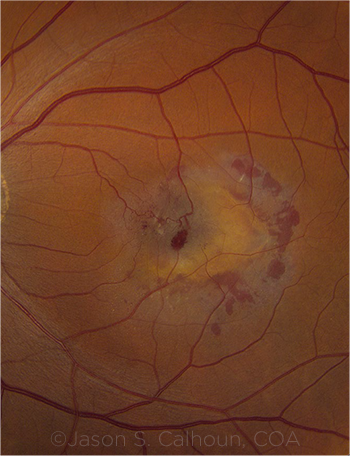Download PDF
A preclinical trial of VEGF-Grab suggests that the novel anti-VEGF agent offers significant potential for VEGF suppression.1
A team of researchers in Korea investigated the safety and efficacy of VEGF-Grab and compared it to aflibercept (Eylea). They found that the in vivo antiangiogenic efficacy of VEGF-Grab was similar to that of aflibercept and that the in vitro anti-VEGF activity of VEGF-Grab was superior to that of aflibercept. The retinal safety profiles were comparable for the two drugs.
 |
CANDIDATE DRUG. VEGF-Grab shows promise for retinal diseases such as neovascular AMD (shown here) and diabetic retinopathy.
|
Study rationale. Previous investigations have found that VEGF-Grab has a stronger binding affinity to VEGF and placental growth factor than aflibercept, which suggests that it could be a more efficacious anti-VEGF agent than aflibercept.
By extension, VEGF-Grab’s higher binding ability suggests that it may be more effective than ranibizumab and bevacizumab, said Se Joon Woo, MD, PhD, at the Seoul National University Bundang Hospital in South Korea. “VEGF-Grab promises to be efficacious in patients refractory to the current anti-VEGF agents, as well as in treatment-naive cases,” he said.
In vitro, in vivo. Dr. Woo and his colleagues quantified the effect of aflibercept and VEGF-Grab on VEGF-induced proliferation and migration. In vitro, VEGF-Grab was a better inhibitor of VEGF-induced cell proliferation/migration than aflibercept. Both agents comparably inhibited proliferation in tube formation assays.
In the in vivo animal model studies, both drugs yielded similar results. Their antiangiogenic effects in mice with oxygen-induced retinopathy were comparable. In rats with laser-induced choroidal neovascularization (CNV), VEGF-Grab and aflibercept showed similar CNV inhibition.
In vivo toxicity from injection was evaluated with light and electron microscopy. Neither drug caused adverse events or significant ocular inflammation arising from injection in treated mouse eyes.
Looking ahead. Detailed preclinical experiments are still needed, especially to confirm safety, Dr. Woo said.
—Miriam Karmel
___________________________
1 Hong HK et al. Invest Ophthalmol Vis Sci. 2020;61(13):22.
___________________________
Relevant financial disclosures—Dr. Woo: None.
For full disclosures and the disclosure key, see below.
Full Financial Disclosures
Dr. Apte EdenRoc Life Sciences: O; Genentech: C; Iveric bio: O; Liberty Biosecurity: C,O; Merck: C; Metro Biotech International: O; Metro International: O,P; Mylan: C; Novartis/Alcon: C; Ribomic: C.
Dr. Lee None.
Dr. Petrova None.
Dr. Woo Abbvie: L; Allergan: L; Alteogen: C,S; Bayer: L; Curacle: C,S; Novartis/Alcon: C,L,S; Novelty Nobility: C,S; Panolos Bioscience: C; Philophos: C; Retimark: O; Samsung Bioepis: C,S; SCAI Therapeutics: L.; Taejoon: L.
Disclosure Category
|
Code
|
Description
|
| Consultant/Advisor |
C |
Consultant fee, paid advisory boards, or fees for attending a meeting. |
| Employee |
E |
Employed by a commercial company. |
| Speakers bureau |
L |
Lecture fees or honoraria, travel fees or reimbursements when speaking at the invitation of a commercial company. |
| Equity owner |
O |
Equity ownership/stock options in publicly or privately traded firms, excluding mutual funds. |
| Patents/Royalty |
P |
Patents and/or royalties for intellectual property. |
| Grant support |
S |
Grant support or other financial support to the investigator from all sources, including research support from government agencies (e.g., NIH), foundations, device manufacturers, and/or pharmaceutical companies. |
|
More from this month’s News in Review